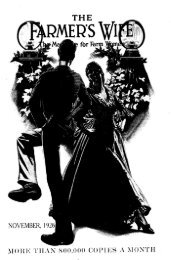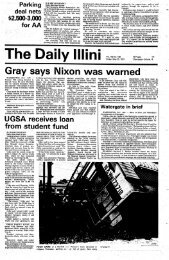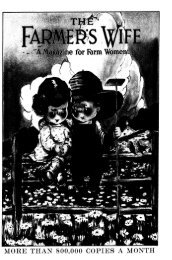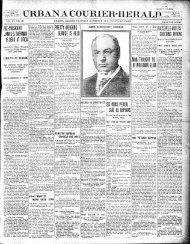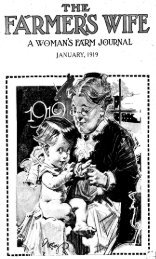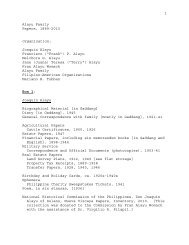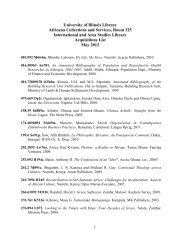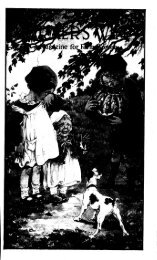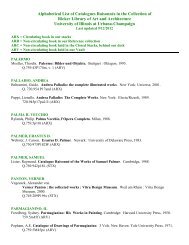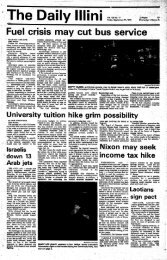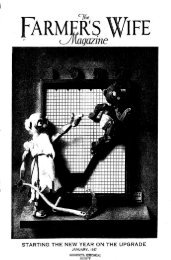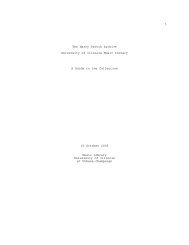Exhibit Catalog for Audubon at Illinois - University of Illinois ...
Exhibit Catalog for Audubon at Illinois - University of Illinois ...
Exhibit Catalog for Audubon at Illinois - University of Illinois ...
You also want an ePaper? Increase the reach of your titles
YUMPU automatically turns print PDFs into web optimized ePapers that Google loves.
Krannert Art Museum<br />
January 30—May 24, 2009<br />
<strong>Audubon</strong> <strong>at</strong> <strong>Illinois</strong>:<br />
Selections from the <strong>University</strong> Library’s<br />
Birds <strong>of</strong> America
©2009<br />
The Rare Book & Manuscript Library,<br />
<strong>University</strong> <strong>of</strong> <strong>Illinois</strong> Board <strong>of</strong> Trustees<br />
Cover—Pl<strong>at</strong>e 159:<br />
Cardinal Grosbeak, 1833 (detail)<br />
Back Cover—Pl<strong>at</strong>e 26:<br />
Carolina Parrot, 1827 or 1828 (detail)<br />
Inside Front Cover—Pl<strong>at</strong>e 316:<br />
Black Bellied Darter, 1836<br />
Title Page (top)—Pl<strong>at</strong>e 47:<br />
Ruby-thro<strong>at</strong>ed Hummingbird, 1828 (detail)<br />
Title Page (bottom)—Pl<strong>at</strong>e 203:<br />
Fresh W<strong>at</strong>er Marsh Hen, 1834<br />
Text: Jo Kibbee<br />
Design: Dennis J. Sears<br />
Photographs:<br />
Laura Larkin<br />
He<strong>at</strong>her Tennison<br />
Dennis J. Sears<br />
ISBN 978-0-9788134-2-0
<strong>Audubon</strong> <strong>at</strong> <strong>Illinois</strong>:<br />
Selections from the <strong>University</strong> Library’s<br />
Birds <strong>of</strong> America<br />
Cur<strong>at</strong>ed by Jo Kibbee<br />
Krannert Art Museum<br />
January 30—May 24, 2009<br />
With support from Jack and K<strong>at</strong>hy Chamblin<br />
and<br />
France@<strong>Illinois</strong>, <strong>University</strong> <strong>of</strong> <strong>Illinois</strong> <strong>at</strong> Urbana-Champaign,<br />
Department <strong>of</strong> French
<strong>Audubon</strong> <strong>at</strong> <strong>Illinois</strong><br />
John James <strong>Audubon</strong> (1785-1851)<br />
never lived in <strong>Illinois</strong>, but his<br />
masterpiece <strong>of</strong> n<strong>at</strong>ural history, Birds<br />
<strong>of</strong> America, has a permanent home<br />
in The Rare Book & Manuscript<br />
Library <strong>at</strong> the <strong>University</strong> <strong>of</strong> <strong>Illinois</strong><br />
<strong>at</strong> Urbana-Champaign. Born on his<br />
f<strong>at</strong>her’s plant<strong>at</strong>ion in wh<strong>at</strong> is now<br />
Haiti and raised in France, <strong>Audubon</strong><br />
made his home and reput<strong>at</strong>ion in<br />
America. This exhibition celebr<strong>at</strong>es<br />
<strong>Audubon</strong>’s mastery <strong>of</strong> ornithological<br />
drawing with a selection <strong>of</strong> pl<strong>at</strong>es<br />
th<strong>at</strong> reflect the diversity <strong>of</strong> avian<br />
species found in <strong>Illinois</strong>. Selections <strong>for</strong> the exhibition include examples<br />
<strong>of</strong> birds th<strong>at</strong> thrive in the backyards <strong>of</strong> central <strong>Illinois</strong>, as well<br />
as those inhabiting shorelines, wetlands, woodland, and prairie. Some<br />
birds, including the Northern Cardinal, reside in <strong>Illinois</strong> year-round,<br />
while others are rare visitors, such as the Rose<strong>at</strong>e Spoonbill, sighted<br />
in southern <strong>Illinois</strong> following Hurricane Gustav in 2008. Once found in<br />
to <strong>Illinois</strong>, there is controversy as to whether the Ivory-billed Woodpecker<br />
is extinct, with reports <strong>of</strong> sightings in Louisiana in 2004. The<br />
Carolina Parrot and the Passenger Pigeon will not be seen again in<br />
<strong>Illinois</strong>, or anywhere.<br />
The selected pl<strong>at</strong>es in this exhibition provide scientifically significant<br />
illustr<strong>at</strong>ions <strong>of</strong> American birds, <strong>of</strong> course, but they also demonstr<strong>at</strong>e<br />
<strong>Audubon</strong>’s gre<strong>at</strong> artistry. From the marauding Blue Jay to an<br />
inquisitive Carolina Parrot, <strong>Audubon</strong> sought to capture not only<br />
the physical likeness <strong>of</strong> the birds he painted, but also their essence. He<br />
unflinchingly depicts the harsh realities <strong>of</strong> the n<strong>at</strong>ural world, as seen in<br />
his portrayal <strong>of</strong> a family <strong>of</strong> Virginia Partridge (Northern Bobwhite) under<br />
<strong>at</strong>tack by a Red-Shouldered Hawk, and the Golden Eagle carrying <strong>of</strong>f<br />
a white hare. Pl<strong>at</strong>es <strong>of</strong> the Barn Swallow and Gre<strong>at</strong> Tern are elegant<br />
in their stark simplicity, while others, such as Henslow’s Bunting and the<br />
Pinne<strong>at</strong>ed Grous (Gre<strong>at</strong>er Prairie Chicken), depict birds in their n<strong>at</strong>ural<br />
habit<strong>at</strong>s—habit<strong>at</strong>s th<strong>at</strong> are increasingly jeopardized by development.
<strong>Audubon</strong> was very much a product <strong>of</strong> his time. Though he would<br />
l<strong>at</strong>er decry the wanton killing <strong>of</strong> birds, particularly <strong>for</strong> the fashion<br />
industry, <strong>Audubon</strong> was himself an avid hunter and worked from<br />
specimens he had killed. The tiny figure <strong>of</strong> a hunter in the pl<strong>at</strong>e <strong>of</strong><br />
the Snowy Heron, or White Egret is thought to be a self-portrait.<br />
<strong>Audubon</strong> drew and painted from specimens he arranged, but<br />
his w<strong>at</strong>ercolors were transferred to the engravers’ pl<strong>at</strong>e by the<br />
talented Robert Havell, Jr. The prints themselves were produced by<br />
a combin<strong>at</strong>ion <strong>of</strong> engraving, aqu<strong>at</strong>int, and etching, and were handcolored<br />
in Havell’s studio. The work was particularly challenging since<br />
<strong>Audubon</strong>’s birds were depicted life-sized and required large sheets <strong>of</strong><br />
paper (averaging 38 x 26 inches) <strong>for</strong> the prints. <strong>Audubon</strong> chose wove<br />
paper (made on a very fine wire mesh) from the J. Wh<strong>at</strong>man Mill in<br />
Maidstone, England—the finest paper available <strong>at</strong> the time. A total <strong>of</strong><br />
435 pl<strong>at</strong>es were printed and sold by subscription in groups <strong>of</strong> five. The<br />
pl<strong>at</strong>es were l<strong>at</strong>er bound in four volumes and, owing to their impressive<br />
size, are <strong>of</strong>ten referred to as the double elephant folio. <strong>Audubon</strong> also<br />
published a five-volume commentary on the n<strong>at</strong>ural history <strong>of</strong> the<br />
birds, entitled Ornithological Biography (1832). This work is held by<br />
The Rare Book & Manuscript Library <strong>at</strong> the <strong>University</strong> <strong>of</strong> <strong>Illinois</strong> <strong>at</strong><br />
Urbana-Champaign.<br />
3
4<br />
Thanks to the vision <strong>of</strong> the l<strong>at</strong>e Robert B. Downs, Dean <strong>of</strong> the <strong>University</strong><br />
Library from 1943 to 1971, the Library acquired an original set <strong>of</strong> Birds<br />
<strong>of</strong> America. Downs had long hoped to secure this crown jewel <strong>for</strong> The<br />
Rare Book & Manuscript Library’s already impressive collection <strong>of</strong> rare<br />
ornithological books. In 1948, he seized an opportunity to purchase<br />
it from the Brooks School in North Andover, Massachusetts. The set is<br />
one <strong>of</strong> only 120 remaining complete sets <strong>of</strong> the original printing.<br />
The massive, le<strong>at</strong>her-bound volumes were housed in The Rare Book<br />
& Manuscript Library, where the open pages were displayed in a<br />
specially-constructed case. The original display conditions were<br />
not optimal, however, and the pl<strong>at</strong>es themselves were badly in need<br />
<strong>of</strong> restor<strong>at</strong>ion. In 1988, the Library Friends undertook an extensive<br />
fundraising ef<strong>for</strong>t to restore the prints. At th<strong>at</strong> time, the volumes<br />
were disbound and each individual pl<strong>at</strong>e was pr<strong>of</strong>essionally and<br />
painstakingly restored. Thanks to the <strong>for</strong>esight and generosity <strong>of</strong><br />
the <strong>University</strong> <strong>of</strong> <strong>Illinois</strong> Library Friends, <strong>Audubon</strong>’s legacy will<br />
continue to inspire and delight gener<strong>at</strong>ions to come.<br />
References:<br />
Low, Susanne. A Guide to <strong>Audubon</strong>’s Birds <strong>of</strong> America. New Haven<br />
and New York: William Reese Company & Donald A. Heald, 2002.<br />
Vedder, Lee A. John James <strong>Audubon</strong> and The Birds <strong>of</strong> America: A Visionary<br />
Achievement in Ornithological Illustr<strong>at</strong>ion. San Marino, CA: Huntington<br />
Library Press, 2006.
Pl<strong>at</strong>es in the <strong>Exhibit</strong>ion<br />
(some shown in detail)<br />
Pl<strong>at</strong>e 1: Gre<strong>at</strong> American Cock Male (Wild Turkey), 1827 or 1828<br />
Hand-colored engraving by W. H. Lizars (1788-1859)<br />
As <strong>Audubon</strong>’s favorite bird, the wild turkey holds the distinction <strong>of</strong><br />
being the first pl<strong>at</strong>e in the collection.<br />
Pl<strong>at</strong>e 7: Purple Grackle<br />
(Common Grackle), 1827<br />
or 1828<br />
Hand-colored engraving<br />
with etching by W. H.<br />
Lizars (1788-1859)<br />
Pl<strong>at</strong>e 181: Golden Eagle, 1833<br />
Hand-colored engraving with<br />
aqu<strong>at</strong>int and etching by Robert<br />
Havell Jr. (1793-1878)<br />
<strong>Audubon</strong> pr<strong>of</strong>essed to have studied<br />
with French Neo-Classical painter<br />
Jacques Louis David (1748-1825),<br />
though scholars dispute his claim.<br />
However, <strong>Audubon</strong>’s monumental<br />
Golden Eagle reflects the influence <strong>of</strong><br />
painters from his n<strong>at</strong>ive France.
Pl<strong>at</strong>e 12: Baltimore Oriole, 1827<br />
Engraving with aqu<strong>at</strong>int and etching by Robert Havell Jr. (1793-1878)<br />
and colored by Robert Havell Sr. (1769–1832)<br />
<strong>Audubon</strong> frequently employed the talents <strong>of</strong> other n<strong>at</strong>ure artists to paint<br />
the richly-detailed backgrounds <strong>for</strong> his birds. These uncredited artists<br />
include thirteen-year-old Joseph Mason, whose work is represented<br />
here. Other collabor<strong>at</strong>ors include George Lehman and Maria Martin, as<br />
well as his wife Lucy Bakewell <strong>Audubon</strong> and sons Victor and John.<br />
Pl<strong>at</strong>e 159: Cardinal Grosbeak (Northern Cardinal), 1833<br />
Hand-colored engraving with aqu<strong>at</strong>int and etching by Robert<br />
Havell Jr. (1793-1878)<br />
7
8<br />
Pl<strong>at</strong>e 102: Blue Jay, 1830 or 1831<br />
Hand-colored engraving with aqu<strong>at</strong>int and etching by Robert<br />
Havell Jr. (1793-1878)<br />
<strong>Audubon</strong> ascribed human qualities to the birds he studied: “…more<br />
tyrannical than brave, and, like most boasters, domineers over the<br />
feeble, dreads the strong, and flies even from his equals. In many<br />
cases, in fact, he is a downright coward”—Ornithological Biography<br />
Pl<strong>at</strong>e 97: Mottled Screech Owl (Eastern Screech Owl), 1830<br />
Hand-colored engraving with aqu<strong>at</strong>int and etching by Robert<br />
Havell Jr. (1793-1878)<br />
Pl<strong>at</strong>e 47: Ruby-thro<strong>at</strong>ed Humming Bird, 1828<br />
Hand-colored engraving with aqu<strong>at</strong>int and etching by Robert<br />
Havell Jr. (1793-1878)
Pl<strong>at</strong>e 173: Barn<br />
Swallow, 1833<br />
Hand-colored<br />
engraving with<br />
aqu<strong>at</strong>int and<br />
etching by<br />
Robert Havell Jr.<br />
(1793-1878)<br />
Pl<strong>at</strong>e 21: The Mocking Bird (Northern Mockingbird), 1827 or 1828<br />
Hand-colored engraving with aqu<strong>at</strong>int and etching by Robert<br />
Havell Jr. (1793-1878)<br />
<strong>Audubon</strong>’s critics disputed the accuracy <strong>of</strong> his represent<strong>at</strong>ion <strong>of</strong> the<br />
timber r<strong>at</strong>tlesnake, arguing th<strong>at</strong> the fangs do not curl outward <strong>at</strong><br />
the tips and noting th<strong>at</strong> these snakes rarely climb trees.<br />
9
Pl<strong>at</strong>e 211: Gre<strong>at</strong> Blue Heron, 1834<br />
Hand-colored engraving with<br />
aqu<strong>at</strong>int and etching by Robert<br />
Havell Jr. (1793-1878)<br />
The heron’s seemingly awkward<br />
pose is an example <strong>of</strong> the<br />
compositional device <strong>Audubon</strong><br />
employed by necessity to meet the<br />
challenge <strong>of</strong> fitting a life-sized<br />
portrait onto a 38 x 26 inch sheet<br />
<strong>of</strong> paper<br />
Pl<strong>at</strong>e 76: Virginia Partridge<br />
(Northern Bobwhite), 1830<br />
Hand-colored engraving<br />
with aqu<strong>at</strong>int and etching by<br />
Robert Havell Jr. (1793-1878)<br />
Pl<strong>at</strong>e 306: Gre<strong>at</strong><br />
Northern Diver or<br />
Loon (Common<br />
Loon), 1836<br />
Hand-colored<br />
engraving with<br />
aqu<strong>at</strong>int and<br />
etching by<br />
Robert Havell Jr.<br />
(1793-1878)
Pl<strong>at</strong>e 321: Rose<strong>at</strong>e Spoonbill, 1836.<br />
Hand-colored engraving with aqu<strong>at</strong>int and etching by Robert<br />
Havell Jr., (1793-1878)<br />
Though not a common bird in <strong>Illinois</strong>, the Rose<strong>at</strong>e Spoonbill has<br />
recently been reported along the Mississippi River in southern<br />
<strong>Illinois</strong>, most likely as a consequence <strong>of</strong> Hurricane Gustav (2008).<br />
Pl<strong>at</strong>e 242: Snowy Heron or White Egret (Snowy Egret), 1835<br />
Hand-colored engraving, with aqu<strong>at</strong>int and etching by Robert<br />
Havell Jr. (1793-1878)<br />
Pl<strong>at</strong>e 66: Ivory-billed<br />
Woodpecker, 1829<br />
Engraving, with aqu<strong>at</strong>int and<br />
etching by Robert Havell Jr.<br />
(1793-1878) and colored by<br />
Robert Havell Sr. (1769-1832)<br />
“I have always imagined, th<strong>at</strong><br />
in the plumage <strong>of</strong> the beautiful<br />
Ivory-billed Woodpecker, there<br />
is something very closely allied<br />
to the style <strong>of</strong> colouring <strong>of</strong><br />
the gre<strong>at</strong> VANDYKE.”<br />
—Ornithological Biography<br />
11
Pl<strong>at</strong>e 62: Passenger<br />
Pigeon, 1829<br />
Engraving with aqu<strong>at</strong>int<br />
and etching by Robert<br />
Havell Jr. (1793-1878) and<br />
colored by Robert Havell<br />
Sr. (1769-1832)<br />
Pl<strong>at</strong>e 203: Fresh W<strong>at</strong>er Marsh Hen (King Rail), 1834<br />
Hand-colored engraving with aqu<strong>at</strong>int and etching by Robert<br />
Havell Jr. (1793-1878)<br />
Pl<strong>at</strong>e 316: Black-bellied Darter (Anhinga), 1836<br />
Hand-colored engraving with aqu<strong>at</strong>int and etching by Robert<br />
Havell Jr. (1793-1878)<br />
Pl<strong>at</strong>e 309: Gre<strong>at</strong> Tern (Common Tern), 1836<br />
Hand-colored engraving with aqu<strong>at</strong>int<br />
and etching by Robert Havell Jr.<br />
(1793-1878)<br />
Pl<strong>at</strong>e 70: Henslow’s Bunting<br />
(Henslow’s Sparrow), 1829<br />
Engraving with aqu<strong>at</strong>int and etching<br />
by Robert Havell Jr. (1793-1878)<br />
and colored by Robert Havell Sr.<br />
(1769-1832)<br />
Pl<strong>at</strong>e 26: Carolina Parrot (Carolina Parakeet), 1827 or 1828<br />
Engraving with etching and coloring by Robert Havell Sr. (1769-1832)<br />
and Robert Havell Jr. (1793-1878)<br />
Pl<strong>at</strong>e 122: Blue Grosbeak,<br />
1831 or 1832<br />
Hand-colored engraving<br />
with aqu<strong>at</strong>int and etching by<br />
Robert Havell Jr. (1793-1878)
Pl<strong>at</strong>e 186: Pinne<strong>at</strong>ed Grous (Gre<strong>at</strong>er Prairie Chicken), 1834<br />
Hand-colored engraving, with aqu<strong>at</strong>int and etching by Robert Havell<br />
Jr. (1793-1878)<br />
Special thanks to Alvan Bregman, Valerie Hotchkiss, Gregory Lambeth,<br />
Laura Larkin, He<strong>at</strong>her Murphy, Carrie Pirmann, Diane Schmidt, and<br />
Vicki Trimble <strong>for</strong> their help with this exhibition.<br />
Additional picture credits:<br />
Page 2—John Symes, John James<br />
<strong>Audubon</strong>, 1785-1857, The N<strong>at</strong>uralist<br />
as Frontiersman, Oil, 1826<br />
Page 3—Pl<strong>at</strong>e 242: Snowy Heron<br />
or White Egret (Snowy Egret), 1835<br />
Page 4—Pl<strong>at</strong>e 70: Henslow’s Bunting<br />
(Henslow’s Sparrow), 1829<br />
Page 13—Pl<strong>at</strong>e 97: Mottled Screech<br />
Owl (Eastern Screech Owl), 1830<br />
Printed on Recycled Paper<br />
13




